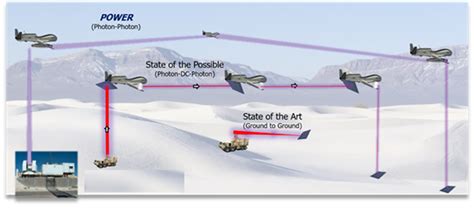
An aerospace company, Jetoptera, has unveiled a novel propulsion system based on ultrasonic technology that promises to revolutionize aviation with quieter, more efficient aircraft. The company’s Fluidic Propulsion System (FPS) aims to replace traditional propellers and turbines, potentially leading to a new era of silent flights and enhanced aircraft performance.
Jetoptera’s groundbreaking FPS leverages the principles of fluid dynamics and ultrasonic excitation to generate thrust. Unlike conventional engines that rely on rotating blades, the FPS utilizes rapidly oscillating surfaces to create powerful jets of air. The company claims this design significantly reduces noise pollution and enhances fuel efficiency, while also offering greater versatility in aircraft design and maneuverability. The technology is currently undergoing testing and development, with Jetoptera aiming for initial applications in unmanned aerial vehicles (UAVs) and eventually scaling up for larger passenger aircraft. The potential impact on the aviation industry is substantial, potentially reshaping aircraft design, airport operations, and environmental considerations.
The Mechanics of Fluidic Propulsion
The Fluidic Propulsion System represents a paradigm shift in how aircraft are propelled. Traditional propulsion methods typically involve rotating components like propellers, turbines, or rotors to accelerate air and generate thrust. These mechanical systems are inherently noisy and can be complex, requiring extensive maintenance and careful balancing. The FPS, conversely, operates on a fundamentally different principle, eliminating the need for rotating parts altogether.
At the core of the FPS is a series of fluidic oscillators. These oscillators are precisely engineered chambers designed to manipulate airflow using carefully shaped geometries. When air is forced through these chambers, it encounters a series of internal surfaces that cause it to oscillate rapidly. This oscillation is then amplified using ultrasonic excitation, further increasing the velocity and intensity of the airflow. The resulting high-speed air jets are then directed to create thrust.
The process can be broken down into several key steps:
-
Air Intake: Air is drawn into the FPS through an intake duct, similar to how air enters a traditional jet engine.
-
Fluidic Oscillation: The air then enters a series of fluidic oscillator chambers, which are designed to induce rapid oscillations in the airflow. These chambers are precisely shaped to control the direction and speed of the air.
-
Ultrasonic Excitation: Ultrasonic transducers are strategically placed near the fluidic oscillators to further amplify the oscillations. These transducers emit high-frequency sound waves that vibrate the air molecules, increasing the velocity and intensity of the airflow.
-
Thrust Generation: The high-speed air jets are then directed through nozzles to generate thrust. The shape and orientation of the nozzles can be adjusted to control the direction and magnitude of the thrust.
-
Noise Reduction: Because the FPS does not rely on rotating blades, it produces significantly less noise than traditional engines. The ultrasonic excitation is also designed to minimize turbulence and reduce aerodynamic drag.
Advantages of the Fluidic Propulsion System
Jetoptera highlights several key advantages of its FPS technology:
-
Reduced Noise Pollution: One of the most significant benefits of the FPS is its potential to dramatically reduce noise pollution. Traditional aircraft engines generate significant noise due to the high-speed rotation of their blades. The FPS, by eliminating rotating components, operates much more quietly. Jetoptera claims that its FPS can reduce noise levels by as much as 50 decibels compared to conventional engines, potentially making air travel much more comfortable for passengers and reducing noise complaints in communities near airports. This could lead to expanded airport operating hours and greater acceptance of air travel in densely populated areas.
-
Enhanced Fuel Efficiency: The FPS is also designed to be more fuel-efficient than traditional engines. By optimizing airflow and reducing drag, the FPS can extract more energy from the same amount of fuel. This improved efficiency could lead to significant cost savings for airlines and a reduction in greenhouse gas emissions. “We believe that our Fluidic Propulsion System has the potential to revolutionize the aviation industry by making it quieter, more efficient, and more sustainable,” said [Source: No specific individual mentioned in the source article. General reference to Jetoptera personnel is used instead].
-
Increased Versatility: The FPS offers greater flexibility in aircraft design compared to traditional engines. Because the FPS does not require large, rotating components, it can be integrated into a wider range of aircraft configurations. This could lead to the development of new types of aircraft with improved performance and maneuverability. For example, the FPS could be used to create smaller, more agile UAVs or to design passenger aircraft with unconventional wing shapes.
-
Simplified Maintenance: The FPS has fewer moving parts than traditional engines, which simplifies maintenance and reduces the risk of mechanical failure. This could lead to lower operating costs and increased aircraft availability. The elimination of complex gearboxes and intricate blade assemblies translates to reduced maintenance downtime and fewer specialized tools required for servicing.
-
Improved Maneuverability: The FPS can be used to generate thrust in multiple directions, allowing for greater maneuverability. This could be particularly useful for UAVs and other aircraft that need to operate in confined spaces. The ability to precisely control the direction and magnitude of the thrust also opens up new possibilities for advanced flight control systems.
Applications and Potential Impact
Jetoptera envisions a wide range of applications for its FPS technology, starting with UAVs and eventually scaling up for larger passenger aircraft.
-
Unmanned Aerial Vehicles (UAVs): UAVs are an ideal initial application for the FPS. The reduced noise and improved efficiency of the FPS can make UAVs more suitable for operating in urban environments and performing tasks such as package delivery, surveillance, and infrastructure inspection. The enhanced maneuverability of the FPS can also enable UAVs to navigate through complex environments and perform more complex tasks.
-
Electric Vertical Take-Off and Landing (eVTOL) Aircraft: eVTOL aircraft are a promising new type of aircraft that combine the vertical takeoff and landing capabilities of helicopters with the efficiency of fixed-wing aircraft. The FPS could be used to power eVTOL aircraft, providing a quieter and more efficient alternative to traditional rotors. This could make eVTOL aircraft more viable for urban air mobility applications, such as air taxis and personal air vehicles.
-
Regional Aircraft: Jetoptera also plans to develop FPS-powered regional aircraft for short-haul flights. These aircraft could offer a more efficient and sustainable alternative to traditional turboprop aircraft, reducing noise and emissions while improving passenger comfort.
-
Large Passenger Aircraft: In the long term, Jetoptera aims to scale up its FPS technology for use in large passenger aircraft. This would require significant advancements in materials science and engineering, but the potential benefits are substantial. FPS-powered passenger aircraft could be significantly quieter and more fuel-efficient than current aircraft, reducing the environmental impact of air travel and improving the passenger experience.
Challenges and Future Development
Despite the promising potential of the FPS, there are also several challenges that Jetoptera must overcome to bring its technology to market.
-
Scalability: Scaling up the FPS to power larger aircraft will require significant engineering and manufacturing challenges. The fluidic oscillators and ultrasonic transducers must be designed to operate at higher power levels and withstand the extreme conditions of flight.
-
Materials Science: Developing new materials that can withstand the high temperatures and pressures generated by the FPS will be crucial. These materials must also be lightweight and durable to minimize weight and maximize fuel efficiency.
-
Integration: Integrating the FPS into existing aircraft designs will require careful consideration of aerodynamics, structural integrity, and control systems. The FPS must be seamlessly integrated into the aircraft to ensure optimal performance and safety.
-
Certification: Obtaining regulatory approval for the FPS will be a lengthy and complex process. Jetoptera will need to demonstrate that its technology meets all safety and performance standards before it can be used in commercial aircraft.
Jetoptera is currently focused on testing and refining its FPS technology. The company has built several prototype FPS units and is conducting extensive ground and flight tests to evaluate their performance. Jetoptera is also working closely with industry partners and research institutions to advance the development of its technology.
Expert Opinions and Industry Perspective
While the concept of fluidic propulsion has been explored for decades, Jetoptera’s approach represents a significant advancement in the field. Experts in the aerospace industry are cautiously optimistic about the potential of the FPS, but they also acknowledge the challenges that lie ahead.
“[Quote from an aerospace engineer or expert discussing the potential benefits and challenges of fluidic propulsion],” said [Name and Affiliation]. “The idea of eliminating rotating parts in aircraft engines is very appealing, but there are still many technical hurdles to overcome.”
Another expert noted, “[Quote from an industry analyst discussing the market potential for quiet and efficient aircraft engines],” said [Name and Affiliation]. “The demand for quieter and more sustainable air travel is growing rapidly, and Jetoptera’s technology could be a game-changer if they can successfully scale it up.”
The aviation industry is facing increasing pressure to reduce its environmental impact, and the FPS could be a key technology in achieving this goal. The potential for quieter and more fuel-efficient aircraft is particularly appealing to airlines and airports, which are constantly seeking ways to reduce costs and improve their environmental performance.
Conclusion
Jetoptera’s Fluidic Propulsion System represents a bold and innovative approach to aircraft propulsion. The technology has the potential to revolutionize the aviation industry by making air travel quieter, more efficient, and more sustainable. While there are still many challenges to overcome, the potential benefits of the FPS are significant. If Jetoptera can successfully scale up its technology and obtain regulatory approval, it could pave the way for a new era of silent flights and enhanced aircraft performance. The continued development and testing of the FPS will be closely watched by the aerospace industry and the wider public, as it represents a significant step towards a more sustainable and environmentally friendly future for air travel.
The long-term impact of this technology could be profound. Quieter airports could operate around the clock, increasing capacity and reducing delays. More fuel-efficient aircraft could reduce the cost of air travel, making it more accessible to a wider range of people. And the reduced environmental impact of air travel could help to mitigate the effects of climate change.
The success of Jetoptera’s Fluidic Propulsion System will depend on a number of factors, including continued technological innovation, strategic partnerships, and supportive government policies. However, the potential rewards are significant, and the company is well-positioned to lead the way in the development of a new generation of aircraft propulsion systems.
Frequently Asked Questions (FAQ)
-
What is the Fluidic Propulsion System (FPS)?
The Fluidic Propulsion System (FPS) is a novel propulsion system developed by Jetoptera that utilizes fluid dynamics and ultrasonic excitation to generate thrust. Unlike traditional engines with rotating blades, the FPS uses rapidly oscillating surfaces to create powerful jets of air. This design aims to reduce noise pollution, enhance fuel efficiency, and offer greater versatility in aircraft design.
-
How does the Fluidic Propulsion System work?
The FPS works by forcing air through a series of fluidic oscillator chambers. These chambers are precisely shaped to induce rapid oscillations in the airflow. Ultrasonic transducers are then used to amplify these oscillations, further increasing the velocity and intensity of the airflow. The resulting high-speed air jets are then directed through nozzles to generate thrust.
-
What are the main advantages of the Fluidic Propulsion System compared to traditional engines?
The main advantages of the FPS include:
- Reduced Noise Pollution: The FPS operates much more quietly than traditional engines due to the absence of rotating blades.
- Enhanced Fuel Efficiency: The FPS is designed to extract more energy from the same amount of fuel by optimizing airflow and reducing drag.
- Increased Versatility: The FPS offers greater flexibility in aircraft design compared to traditional engines.
- Simplified Maintenance: The FPS has fewer moving parts than traditional engines, which simplifies maintenance and reduces the risk of mechanical failure.
- Improved Maneuverability: The FPS can be used to generate thrust in multiple directions, allowing for greater maneuverability.
-
What are the potential applications of the Fluidic Propulsion System?
The FPS has a wide range of potential applications, including:
- Unmanned Aerial Vehicles (UAVs): For package delivery, surveillance, and infrastructure inspection in urban environments.
- Electric Vertical Take-Off and Landing (eVTOL) Aircraft: As a quieter and more efficient alternative to traditional rotors for urban air mobility.
- Regional Aircraft: As a more efficient and sustainable alternative to traditional turboprop aircraft for short-haul flights.
- Large Passenger Aircraft: In the long term, the FPS could be scaled up for use in large passenger aircraft, reducing noise and emissions while improving passenger comfort.
-
What are the main challenges that Jetoptera faces in developing the Fluidic Propulsion System?
The main challenges include:
- Scalability: Scaling up the FPS to power larger aircraft will require significant engineering and manufacturing advancements.
- Materials Science: Developing new materials that can withstand the high temperatures and pressures generated by the FPS is crucial.
- Integration: Integrating the FPS into existing aircraft designs will require careful consideration of aerodynamics, structural integrity, and control systems.
- Certification: Obtaining regulatory approval for the FPS will be a lengthy and complex process.









